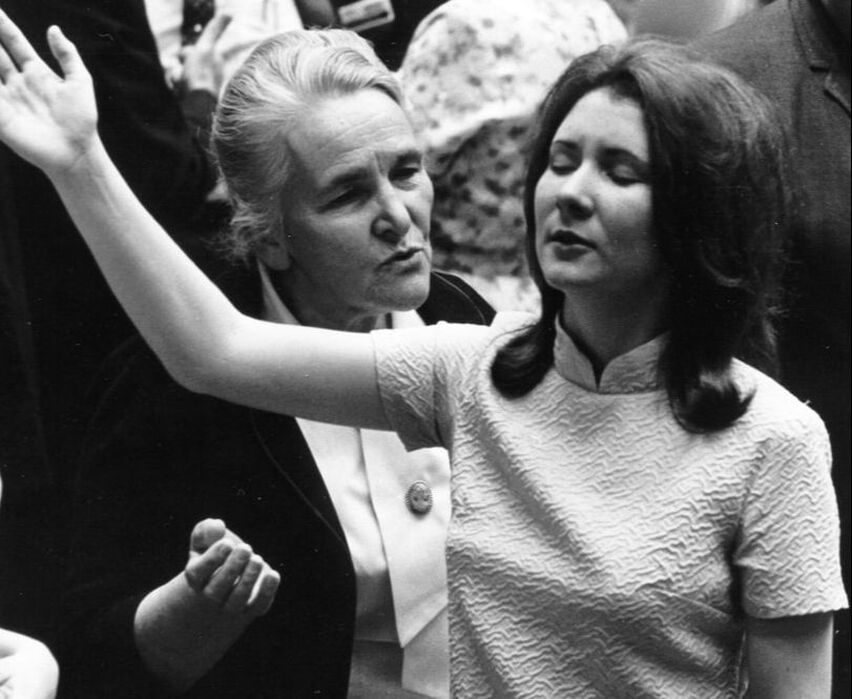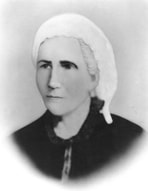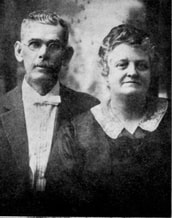WOMEN AT THE GENERAL ASSEMBLY
Louis F. Morgan and David G. Roebuck
WOMEN HAVE been a dynamic and integral part of the history of God’s people from the creation of the human race. The Bible records the significance of women in a wide range of roles, including mother, prophetess, apostle, and even military leader. The history of Christianity reveals that women have been vital in fulfilling the Great Commission, from preaching to making disciples in homes, churches, and communities.
Likewise, women have been integral in the Church of God from our founding at Barney Creek. They provide significate ministries at our International General Assemblies in a variety of activities including business, the ministry of the Word, and support of Assembly operations.
Likewise, women have been integral in the Church of God from our founding at Barney Creek. They provide significate ministries at our International General Assemblies in a variety of activities including business, the ministry of the Word, and support of Assembly operations.
|
|
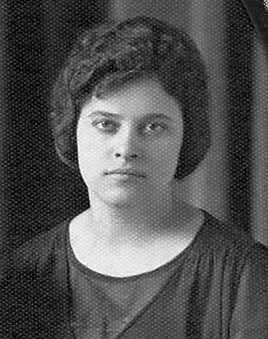 General Overseer F.J. Lee invited Evangelist
General Overseer F.J. Lee invited Evangelist Lettie Cross to preach to youth at the
1924 General Assembly.
Ministry at the General Assembly
Women have been involved in ministry of the Word from the earliest years of the Church of God. As early as 1897, R.G. Spurling credentialed Dorcas Louiza Freeman to preach the gospel. The 1908 Assembly recognized women as deaconesses, and the 1909 Assembly agreed that “women who engage in the ministry of the Word” should be acknowledged and provided a ministerial license (A. 1909, handwritten minutes, p. 40). Other Assemblies have discussed various rights, responsibilities, and titles of women in ministry. Although Tomlinson limited women’s participation in business, he was quick to encourage them in the preaching ministry and recognized that the Great Commission can never be fulfilled without their inclusion in ministry.
Women have been featured prominently since the earliest Assemblies by offering prayers, welcome speeches, sermons, testimonies, and music. Evangelist Sallie O. Lee is the first woman recorded preaching at the General Assembly. At the 8th Assembly in January 1913, she “brought the message” at the Wednesday evening evangelistic service and, as a result, “several received the Holy Ghost” (A. Jan. 1913, p. 44). A few of the women who have been called to preach at the Assembly through the years include Lettie Cross, Loida Camacho, Jacqueline Smith, Joycelyn Barnett, and Ana Ruth Diaz.
On many occasions, women have led special Assembly services such as the orphanage, youth, and women’s services. Following the establishment of a women’s ministries program in 1929, which first was called “Ladies Willing Workers Band” (LWWB), a women’s service was eventually added to the Assembly program. This service frequently included women who had planned the service, the wife of the general overseer, who served as president of the international LWWB, and later the executive secretary of women’s ministries, who was first appointed in 1964. These services often culminated with a sermon by a female minister. These programs gave cause for rejoicing upon hearing the testimonies of the significant contributions of women in the overall ministries of the Church. At the Assembly of 1954 in Memphis, Tennessee, delegates rejoiced upon learning that women’s ministries had raised $1,321,168 for various projects, both locally and internationally, since the previous Assembly.
Women have been involved in ministry of the Word from the earliest years of the Church of God. As early as 1897, R.G. Spurling credentialed Dorcas Louiza Freeman to preach the gospel. The 1908 Assembly recognized women as deaconesses, and the 1909 Assembly agreed that “women who engage in the ministry of the Word” should be acknowledged and provided a ministerial license (A. 1909, handwritten minutes, p. 40). Other Assemblies have discussed various rights, responsibilities, and titles of women in ministry. Although Tomlinson limited women’s participation in business, he was quick to encourage them in the preaching ministry and recognized that the Great Commission can never be fulfilled without their inclusion in ministry.
Women have been featured prominently since the earliest Assemblies by offering prayers, welcome speeches, sermons, testimonies, and music. Evangelist Sallie O. Lee is the first woman recorded preaching at the General Assembly. At the 8th Assembly in January 1913, she “brought the message” at the Wednesday evening evangelistic service and, as a result, “several received the Holy Ghost” (A. Jan. 1913, p. 44). A few of the women who have been called to preach at the Assembly through the years include Lettie Cross, Loida Camacho, Jacqueline Smith, Joycelyn Barnett, and Ana Ruth Diaz.
On many occasions, women have led special Assembly services such as the orphanage, youth, and women’s services. Following the establishment of a women’s ministries program in 1929, which first was called “Ladies Willing Workers Band” (LWWB), a women’s service was eventually added to the Assembly program. This service frequently included women who had planned the service, the wife of the general overseer, who served as president of the international LWWB, and later the executive secretary of women’s ministries, who was first appointed in 1964. These services often culminated with a sermon by a female minister. These programs gave cause for rejoicing upon hearing the testimonies of the significant contributions of women in the overall ministries of the Church. At the Assembly of 1954 in Memphis, Tennessee, delegates rejoiced upon learning that women’s ministries had raised $1,321,168 for various projects, both locally and internationally, since the previous Assembly.
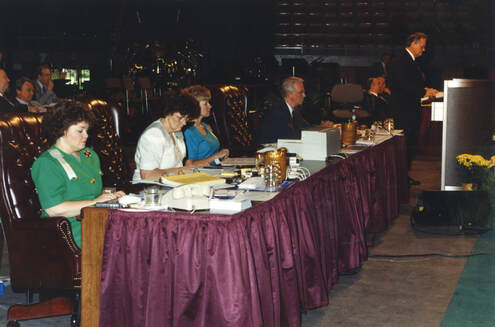 Since at least 1913, women have been vital to
Since at least 1913, women have been vital to the record keeping and operation of the Assembly.
Supporting the Assembly
Along with participation in Assembly business, preaching, music, and special services, many women have served in support roles. Although Pastor Tomlinson served as clerk of the first Assembly and recorded the minutes with his own hand, the historical record reveals that his wife, Mary Jane Tomlinson, was instrumental in printing those minutes.
In his “Prefatory Notes” to the January 1913 Assembly, Tomlinson acknowledged others involved in making the Minutes available. He noted, “The faithful service rendered by E.J. Boehmer, M.T. Whidden, Mrs. Flora E. Trim, and Mrs. Nora Chambers has made it possible to give to the public this brief account of the Assembly just closed, and we feel sure that many will fully appreciate their untiring efforts as they labored day and night” (A. Jan. 1913, p. 3). At today’s International General Assemblies, many men and women provide support. This is especially true of the staff in the Office of Communications, Church of God Publications, and the International General Assembly Cabinet.
Among those providing support are the executive assistants of the International Executive Committee and other divisional leaders. Some of these are seen on the platform assisting the secretary general. Others are behind the scenes typing minutes, assisting in vote counting, working with vendors, and numerous other activities. They too are working day and night so that Assembly delegates may once again conclude, “It seemeth good to the Holy Ghost and us.”
Along with participation in Assembly business, preaching, music, and special services, many women have served in support roles. Although Pastor Tomlinson served as clerk of the first Assembly and recorded the minutes with his own hand, the historical record reveals that his wife, Mary Jane Tomlinson, was instrumental in printing those minutes.
In his “Prefatory Notes” to the January 1913 Assembly, Tomlinson acknowledged others involved in making the Minutes available. He noted, “The faithful service rendered by E.J. Boehmer, M.T. Whidden, Mrs. Flora E. Trim, and Mrs. Nora Chambers has made it possible to give to the public this brief account of the Assembly just closed, and we feel sure that many will fully appreciate their untiring efforts as they labored day and night” (A. Jan. 1913, p. 3). At today’s International General Assemblies, many men and women provide support. This is especially true of the staff in the Office of Communications, Church of God Publications, and the International General Assembly Cabinet.
Among those providing support are the executive assistants of the International Executive Committee and other divisional leaders. Some of these are seen on the platform assisting the secretary general. Others are behind the scenes typing minutes, assisting in vote counting, working with vendors, and numerous other activities. They too are working day and night so that Assembly delegates may once again conclude, “It seemeth good to the Holy Ghost and us.”
Louis F. Morgan, Ph.D., is professor and director of Library Services at Lee University.
David G. Roebuck, Ph.D. is director of the Dixon Pentecostal Research Center, Church of God Historian,
and Assistant Professor of the History of Christianity at Lee University.
David G. Roebuck, Ph.D. is director of the Dixon Pentecostal Research Center, Church of God Historian,
and Assistant Professor of the History of Christianity at Lee University.

